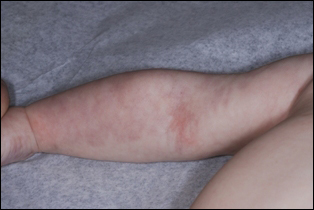2-month-old infant with mottling on leg
Click Here to Manage Email Alerts
A 2-month-old infant girl presents to your clinic with persistent mottling of her right leg.(Figure 1) Her parents state that they noticed mottling on all of her extremities shortly after birth and were initially reassured that it was a normal finding. However, they are concerned that the mottling has resolved elsewhere but persists on her leg. She was full-term and otherwise appears healthy and is thriving. On skin examination, involving her right thigh and lower leg are nearly circumferential violaceous and pink, blanching, reticulated, smooth patches (Figure 1). Her involved thigh and calf also have smaller circumferences than her uninvolved leg. The mottling varies with temperature and activity but persists despite efforts to warm her leg.

What is your diagnosis?
Diagnosis: Cutis Marmorata Telangiectatica Congenita
Discussion: Cutis Marmorata Telangiectatica Congenita (CMTC) is an uncommon vascular malformation that appears at birth and characterized by a localized or generalized reticulate vascular pattern. It most commonly involves an extremity but may also occur in a block pattern on the trunk. CMTC may be isolated or associated with other anomalies. Unlike physiologic cutis marmorata, a transient reticulate erythema commonly seen in newborns that resolves with warming of the skin, the mottled pattern of CMTC is fixed but may fade slightly with warming.
CMTC most commonly occurs sporadically but may have an autosomal dominant transmission in some families. The pathogenesis is unknown.. Currently, no formal classification criteria exist for describing the distribution. The localized form is typically limited to an extremity or the trunk in a segmental, unilateral distribution. The generalized form is more extensive but need not include all of the skin surfaces. The vascular pattern is either a finely reticulated pink or violaceous blanching patch (Figures 1 and 2) or a coarse "train-track-like" pattern (Figure 3).


"train-track-like” pattern.
Cutaneous findings, in addition to the reticulated pattern, include telangiectasias, prominent veins, pallor between veins (nevus anemicus), ulceration, hyperkeratosis and atrophy. . The most common association is limb asymmetry, either atrophy or hypertrophy of the affected limb. CMTC often overlaps with capillary malformations (“port wine stains”).
Non-cutaneous associations include skeletal, ocular, and neurologic anomalies. Skeletal associations are uncommon and include clubfoot, syndactyly, skull asymmetry, osteoporosis and cleft palate among others. Patients with macrocephaly, CMTC, facial and limb asymmetry, neurologic abnormalities, developmental delay, somatic overgrowth and capillary malformations are considered to have macrocephaly-CMTC syndrome (M-CMTC), now known as the Macrocephaly-Capillary Malformation (CM) syndrome. Adams-Oliver Syndrome encompasses patients with CMTC, distal transverse limb defects, and aplasia cutis congenita of the scalp.

Marissa J. Perman is a third-year dermatolology resident at the University of Cincinnati.
The most common ocular abnormality is glaucoma, which may be associated with CMTC or a CM (in a patient with CMTC) in the periocular region. Retinal pigmentation and retinal detachment have also been reported. Neurologic abnormalities include macrocephaly, hydrocephalus, seizures, psychomotor retardation, agenesis of the corpus callosum, cerebral atrophy and dilated ventricles. Other systemic findings reported include cardiac defects and hypothyroidism. Despite the broad range of associated anomalies reported, most patients present with minimal or no associated findings.
CMTC must be differentiated from persistent cutis marmorata found in patients with Down syndrome, Cornelia de Lange syndrome, and homocystinuria. Evaluation includes a thorough physical examination to assess for other associated findings. Limb girth, limb length, and head circumference should be measured. Patients with periocular or facial involvement should be referred to ophthalmology to rule out glaucoma. Likewise, patients with any concern for neurologic impairment should be referred to neurology. The atrophic, “train-track” pattern type of CMTC can be mistaken for vasculitis or even an embolic phenomenon.
The natural course of CMTC in many patients is benign with gradual fading over time. This is commonly seen in the first several years of life. Pulse dye laser has produced variable results. Despite the gradual lightening of the reticulate erythema, associated limb asymmetry persists. The rare ulcerations can be managed with local wound care. Physicians should be aware of the difference between cutis marmorata and CMTC and the possible associated anomalies seen in CMTC.
Marissa J. Perman, MD, is a third-year dermatology resident at the University of Cincinnati.
Garzon MC, Schweiger E. Cutis marmorata telangiectatica congenita. Semin Cutan Med Surg. 2004 Jun;23(2):99-106.
Picascia DD, Esterly NB. Cutis marmorata telangiectatica congenita: report of 22 cases. J Am Acad Dermatol. 1989 Jun;20(6):1098-1104.
Wright DR, Frieden IJ, Orlow SJ, Shin HT, Chamlin S, Schaffer JV, Paller AS. The misnomer “macrocephaly-cutis marmorata telangiectatica congenita syndrome”:report of 12 new cases and support for revising the name to macrocephaly-capillary malformations. Arch Dermatol. 2009 Mar;145(3):287-93.
